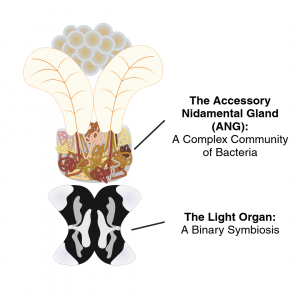
What We Do
Every living organism interacts with all sorts of microbes. The goal of our laboratory is to understand the mechanisms by which animal hosts and beneficial microbial symbionts communicate with an emphasis on how components of the innate immune system may influence these interactions. We use the Hawaiian bobtail squid, Euprymna scolopes as a model system to study the effects of beneficial bacteria on animal host tissues. The bobtai

The bobtail squid has two organs that each form symbioses with bacteria:
- In the light organ, the squid forms a binary relationship with the bioluminescent bacterium, Vibrio fischeri. This simple association has an advantage in that each partner can be raised independently in the laboratory and are readily available for molecular, biochemical, and genetic analyses.
- In the accessory nidamental gland (ANG), the squid houses a complex consortium of bacterial partners that assist in egg defense. This complexity more closely resembles the complexity of other symbioses in nature and helps us understand how hosts interact with a whole community of different bacteria.
By comparing and contrasting these two symbioses found in the same organism, we can identify broad, generalizable themes that govern host-microbe interactions in all sorts of systems.
Recent Lab Publications
Demonstrating how organ structure and microbial community organization contribute to symbiotic defense:
How microbial communities in symbiotic organs relate to evolutionary history:
The formation of a symbiotic organ is dependent on the presence of symbiotic bacteria:
Symbiotic bacteria from the accessory nidamental gland help protect squid eggs:
Contact the Nyholm Lab
| E-mail: | spencer.nyholm@uconn.edu |
|---|---|
| Address: | 91 N. Eagleville Rd Storrs, CT 06269 |